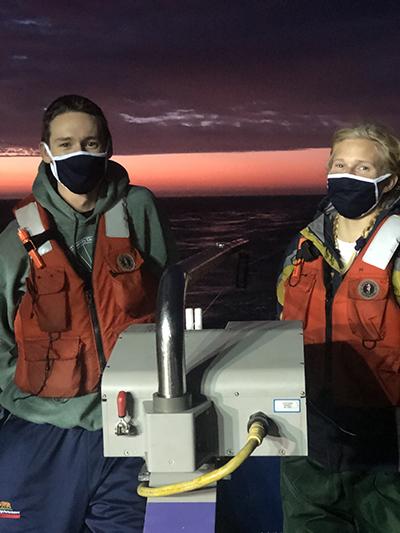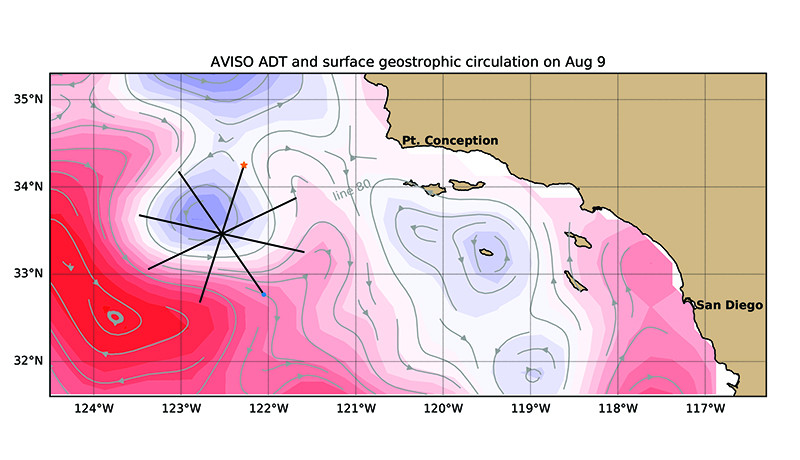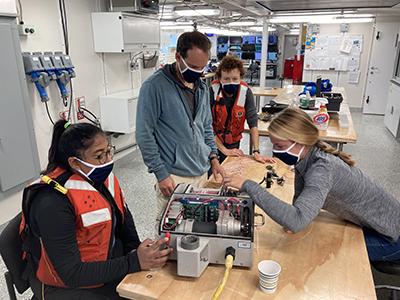Beep beep beep, beep beep beep, I try to convince myself that the 3:30 a.m. alarm is my roommate Winnie’s. Only that can’t be true, because she is still finishing her shift – actually, her watch. I climb (fall) out of my bunk bed aboard Scripps Oceanography Research Vessel Sally Ride and hit the alarm.
Good morning, my name is Evie Gedminas, and I am a rather sleepy undergrad studying mechanical engineering at UC San Diego. This summer I was a part of the Scripps Undergraduate Research Fellowship (SURF), where I explored physical oceanography with Scripps Institution of Oceanography at UC San Diego Professor Sarah Purkey, who hooked me up with this sweet boat gig. Only this cruise was far from a vacation, and it actually gave me my first real hands-on field and lab experience.

staff a winch during a dawn shift.
Photo: Jess Hunt
The goal of this 10-day trip was to make observations that will help validate satellite-estimated ocean currents at high resolution. Together with the three ship’s sonars that profile currents (the Acoustic Doppler Current Profilers, a.k.a. ADCPs), the main piece of equipment we use is called a UCTD probe, which stands for underway conductivity, temperature, and depth. We have three of these little buggers on board, and collectively they have made over 900 dives to 250 meters (820 feet) below the ocean surface. My first job this morning will be operating the winch to drop and reel back in a probe. There are three other jobs on a watch, and we all rotate between jobs over each four-hour watch. While thinking about the jobs that are waiting for me, I finish getting ready, grab my water bottle, and head out onto the stern. I am here to tag team Winnie’s shift. “Good morning, Winnie! Can I please have your life vest, and do you want to introduce yourself to the blog?”
Hey, I am Winnie, and I am not wearing my life vest anymore, which means my watch is done and I can finally get off the deck, which is nice because the graveyard watch is tough. I am an undergrad at Harvey Mudd College, but this summer I’m working with Matt Mazloff at Scripps Institution of Oceanography. [Editor's note: Chu and Gedminas were part of the Scripps Undergraduate Research Fellowship (SURF) program in summer 2020.] I just finished as the logger, which is the person who records all relevant data of each drop. This means the cast number, the drop time, the reel in time, the latitude and the longitude. We are currently tracing out a star pattern about a hundred nautical miles off the coast of Point Conception; this pattern will help evaluate the directionality of the internal waves and of any fronts and small eddies and jets we happen to observe with our instruments. As a logger, I also jot down notes, which can be any relevant piece of information about the drop of the probe. Sometimes this means something went wrong, like a weak spot in the loop splice of the line or a malfunction of the brakes, but sometimes this means we saw an amazing whale throw its tail out of the water. Speaking of animals, I pass a stumbling Jess in the hallway, looking like a baby giraffe brushing his head against the ceiling. He drowsily comments that despite struggling with the motion of the boat, the floorboards don’t let out a single squeak. I reply, “it is what is, innit?” Jess now lumbers on with the blog.
I knock my head against the lab door frame, for the ninth time this cruise. Hi, I am Jess, and I am studying environmental engineering at Princeton University. This summer I worked on the Southern Ocean Carbon and Climate Observations and Modelling (SOCCOM) project, with Scripps PhD student Channing Prend, and Scripps researchers Sarah Gille and Lynne Talley. They told me that working on a research cruise is a vital experience for an aspiring oceanographer, so I graciously took the opportunity. My first position this morning is probe handler (the most important one in my opinion, even if I mostly watch to make sure we maintain focus on our tasks). I am primarily responsible for deploying the probe over the side and for watching as the probe approaches the ship’s stern when it is reeled back up before being sent down again, so it doesn’t hit anything; this down and up and down is repeated approximately every 10 minutes, which gives a resolution of about two kilometers (1.2 miles) between every cast or drop. The probes we use must be switched every two hours so that they can be recharged, cleaned, and have their data downloaded.
When I quality check the data files, I just see columns of numbers, but I know that Chief Scientist (and Scripps Oceanography postdoctoral researcher) Saulo Soares and his team will use these to create beautiful and understandable plots to advance the science of internal waves and other small scale features in the ocean. Also, these soon-to-be publicly available data sets are a unique contribution as this kind of high-resolution and sustained sampling has never been done before.

cruise tracks. Image: Saulo Soares
The first couple hours of my 4 a.m. watch are rough, but the rising sun works like coffee and makes six hours of sleep feel more than adequate. This sunrise means my watch is almost over, confirmed by the sight of Hanne leisurely eating her breakfast before her watch. “Good morning,” she chirps, obviously well rested as she has not had to adjust her sleep schedule as drastically as we have.

Hey, my name is Hanne, and just like Jess I am studying environmental engineering at Princeton University. I also worked on the SOCCOM project this summer, which was a great experience despite the fact that we had to work from home and only met virtually. That made this cruise even more special, because here I got to interact with our 13-member science party (and 20-member crew) in relative proximity while following COVID-19 protocols like mask-wearing, hand-washing, and social distancing. We traded stories with people in all different stages of their careers, which definitely opened my eyes to the wide range of possibilities I can pursue in my future studies. I also learned a lot about the beauties and quirks of oceanography and a lot about the challenges of doing field work – it seems that as much as one plans ahead, there are always unforeseen issues that must be tackled on the fly: whether a total failure of an instrument (like it happened to one of our probes!) or an operational malfunction that prevents safe deployment or recovery of instruments. I’m glad I was able to help readjust the brakes of the UCTD winch a couple of times so that the sampling could go on uninterrupted – after all, no one likes a lot of gaps in their data! Finally, I definitely enjoyed getting a temporary seat at the coolest office, shared with a vast expanse of sea mammals and other scientists and crew members. As we embraced role playing games like Mafia and Codenames on our off-time, we even got a few of the crew members to play along! It was awesome to see how everyone improved at the games as the cruise progressed, our inside jokes and science references spicing things up. Because let’s be honest, there are a lot of cool ships – steel ships, wood ships, pirate ships – but the best ships will always be friendships.
Evie Gedminas is a sophomore studying mechanical engineering at UC San Diego, Winnie Chu is a junior studying climate science at Harvey Mudd College, Jess Hunt is a senior studying environmental engineering at Princeton University, and Hanne Borstlap is a junior studying environmental engineering at Princeton University.
About Scripps Oceanography
Scripps Institution of Oceanography at the University of California San Diego is one of the world’s most important centers for global earth science research and education. In its second century of discovery, Scripps scientists work to understand and protect the planet, and investigate our oceans, Earth, and atmosphere to find solutions to our greatest environmental challenges. Scripps offers unparalleled education and training for the next generation of scientific and environmental leaders through its undergraduate, master’s and doctoral programs. The institution also operates a fleet of four oceanographic research vessels, and is home to Birch Aquarium at Scripps, the public exploration center that welcomes 500,000 visitors each year.
About UC San Diego
At the University of California San Diego, we embrace a culture of exploration and experimentation. Established in 1960, UC San Diego has been shaped by exceptional scholars who aren’t afraid to look deeper, challenge expectations and redefine conventional wisdom. As one of the top 15 research universities in the world, we are driving innovation and change to advance society, propel economic growth and make our world a better place. Learn more at ucsd.edu.